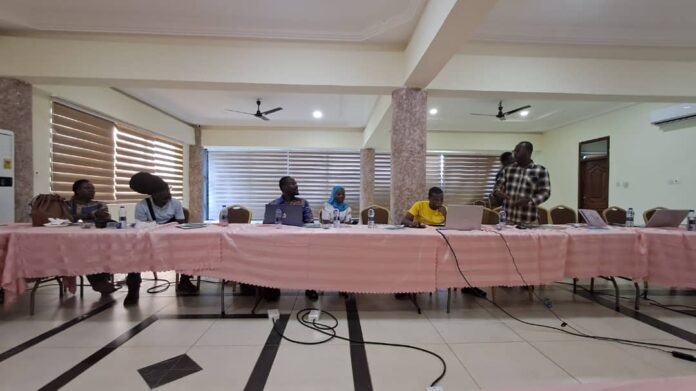Ghana is standing at the edge of an ecological cliff. Over the past 22 years, the country has lost nearly 3,000 hectares of mangrove forests—an area equivalent to 3,000 football fields. These critical ecosystems not only shield coastlines and store carbon but also sustain the livelihoods of thousands of fishing families.
Now, a bold new front has emerged in the battle to protect what remains: the media.
At a high-level workshop held in Cape Coast, seasoned environmental journalists, under the banner of the Journalists for Responsible Fisheries and Environment (JRFE), were equipped with new data and storytelling tools to help reverse the decline. The workshop unveiled the results of Ghana’s most comprehensive mangrove ecosystem assessment to date—conducted under the Sustainable Ocean Project (SOP), a three-year initiative funded by the Norwegian government and led by the Environmental Justice Foundation (EJF) in partnership with Hen Mpoano and CEWEFIA.
Stephen Kankam, Deputy Director of Hen Mpoano, emphasized the urgency of the situation, saying mangroves are not just trees. They are nurseries for our fish, shields against sea-level rise, and vaults of carbon. Yet we are watching them vanish—largely unnoticed. This project is not just about research. It’s about survival.
The Silent Victims of Development
Using satellite data and GIS technology, the assessment mapped dramatic changes in mangrove coverage between 2000 and 2022. It revealed not only widespread forest loss but also a sharp decline in biomass and carbon storage—resulting in over 351,000 tonnes of carbon dioxide equivalent (tCO₂eq) released into the atmosphere due to mangrove destruction.
“That’s more carbon than a small city produces in a year,” noted Justice Mensah, Program Manager at Hen Mpoano. “If mangroves are left out of climate and restoration strategies, we’re missing a huge part of the puzzle.”
According to the assessment, the Volta Region still holds Ghana’s largest remaining mangrove biomass, while the Greater Accra Region has seen its mangroves reduced to scattered patches. Despite signs of regrowth in the Western Region, the national picture remains bleak.
Mangroves are vital breeding grounds for key species like the Blackchin Tilapia, Redbelly Tilapia, and Swimming Crab—staples in coastal diets and economies.
“If we lose the mangroves, we lose the fish. If we lose the fish, we lose food and income,” Mensah warned.
A Media-Driven Turning Point
But hope remains—if action is taken quickly and decisively. And that’s where the media steps in.
“We believe in the power of the press to protect our coasts,” said Kingsley Nana Buadu, President of JRFE. “This story should be on front pages, not buried in the margins.”
Buadu recalled how fishery issues once received little media attention until a committed group of journalists—empowered by NGO training and support—brought the crisis into the spotlight. Their work helped catalyze major policy changes like the fishing closed season.
Now, JRFE is shifting its focus to the Blue Economy, with mangrove protection as a core pillar.
“There are no binding policies protecting mangroves in Ghana,” he added. “But journalism can trigger change—just like it did with fisheries.”
From Data to Dialogue
The Cape Coast workshop marked the launch of a national media campaign. Through hands-on training and access to real-time satellite data, journalists left ready to expose illegal encroachment, celebrate local restoration efforts, and advocate policy change.
“We’re not just telling stories—we’re saving coastlines, one headline at a time,” one participant said.
A Call for Urgent Action
The SOP project, funded by NORAD, is more than an academic study. Its goals are to:
-
Reform fisheries governance and secure fisherfolk rights
-
Strengthen local enterprises and sustainable value chains
-
Build climate resilience through spatial planning and wetland restoration
“This assessment feeds directly into Ghana’s national risk management plan and global fisheries frameworks,” Kankam emphasized. “If mangroves are destroyed, we undermine every step toward a resilient coastal future.”
With sea levels rising and fish stocks dwindling, silence is no longer an option. The data is clear. The media is mobilized.
The question now is: will policy respond before the last mangrove falls?
Key Facts
Mangrove loss: ~3,000 hectares
Carbon emissions from loss: 351,000 tCO₂eq
Biomass decline: From 677,451 Mg to 473,318 Mg
Worst-hit regions: Greater Accra, Volta Estuary
Highest biodiversity: Volta Region
At-risk species: Blackchin Tilapia, Redbelly Tilapia, Swimming Crab, Crevalle Jack
Project Details
Title: Building Grassroots Capacity for a Sustainable Ocean Economy (SOP)
Funded by: Norwegian Government (NORAD)
Implemented by: EJF (lead), Hen Mpoano, CEWEFIA
Regions covered: Western, Central, Greater Accra, and Volta
Focus areas: Fisheries recovery, mangrove conservation, climate adaptation
Source: Ivy Priscilla Setordjie
READ ALSO:


